I first wanted to go to Crete way back when. Probably some 30 years ago. And then I put this desire to the side. It reappeared at the end of 2021 and then I started quite seriously to think about going to Crete in January, but a couple of people who either used to live there or who spent some time there in different periods told me that January was not for Crete. I took their advice. Bearing in mind my interests, I also knew I was not interested in summer months either and so I came up with May, I thought it would be a rather good period for what I planned to do on the biggest Greek island. And this is what I did, i.e., what I visited:
So, let me first say that Crete covers the area of around 8,400 sq. km. The biggest distance along the east-west axis is 260 km and along the north-south axis 60 km. This is also the fifth largest island in the Mediterranean Sea.
There was no direct flight from Belgrade in May and so I bought a ticket via Athens, which turned out to be very important in the end. But, in the beginning the arrival at the airport in Heraklion, the capital of Crete, was very late in the evening. In order to waste as little time as possible, I had booked a taxi already from Belgrade and now it took me to the flat that I had rented for the first couple of days. Although my plan was a comprehensive visit around the island, the first couple of days were linked to Heraklion.
As I’m talking about the transfer from the airport in Heraklion to the centre of the city, it needs to be said that the distance is merely around 5 km. Except by taxi, it is easy during the day to do the transfer by a bus. One only needs to walk for a couple of hundred metres from the exit from the airport building to get to the bus stop (the same goes in the opposite direction when coming to the airport). It is emphasised on the internet that the bus does not stop in front of the airport building itself and that the luggage needs to be taken to the stop that is located “on the road” and this sounds like carrying the luggage for 5 km. It is not really like that. Although the taxi is a much more comfortable option, the advantage of the bus is that it is 10 times cheaper and this is so only if you buy the ticket on the bus (€ 2 vs. € 20). If you buy the ticket at the kiosk by the stop, the ticket price is € 1.10. Still, the buses don’t operate 24 hours a day and one needs to check this in advance. On the other hand, in addition to going to the downtown area, the bus also passes by the main coach terminal in case the visitor wants to go somewhere out of Heraklion right away.
The morning after my arrival I woke up with a rather heavy feeling, but this was probably on account of the flights and the late bedtime. Still, I knew I had no “obligations” for this day, for I had envisaged only relaxed stroll around Heraklion. After some time spent at the room, I decided to have my morning coffee and some kind of a breakfast at a café/bakery in the very centre of the city that was recommended to me by the taxi-driver.
The flat that I had rented was also in the old part of the city and only a few hundred metres away from my coffee-drinking destination, but I basically had to zigzag in order to get there simply because such are the streets in the old part of Heraklion. I was completely impressed by the number of cafés in the city. In the morning they were mostly empty, but the noise from the surroundings I could hear when I arrived the night before clearly suggested that the cafés and restaurants were full in the evening.
This café/bakery that I was going to is situated at the central square in the old part of Heraklion that is officially called Eleftheriou Venizelou Square, but the usual name is Lions Square. The reason is quite clear. In the middle of the square there is a beautiful fountain from the 17th century (with some parts of it dating back to the 14th century), the period when Crete was ruled by Venetians, where among the myriad of decorative details lion sculptures stand out the most. Thus, the founding is unofficially also called the Lions, while its official name that is rarely used is Morossini Fountain. This official name was given to the fountain after Francesco Morossini, a Venetian doge in the period 1688-1694.
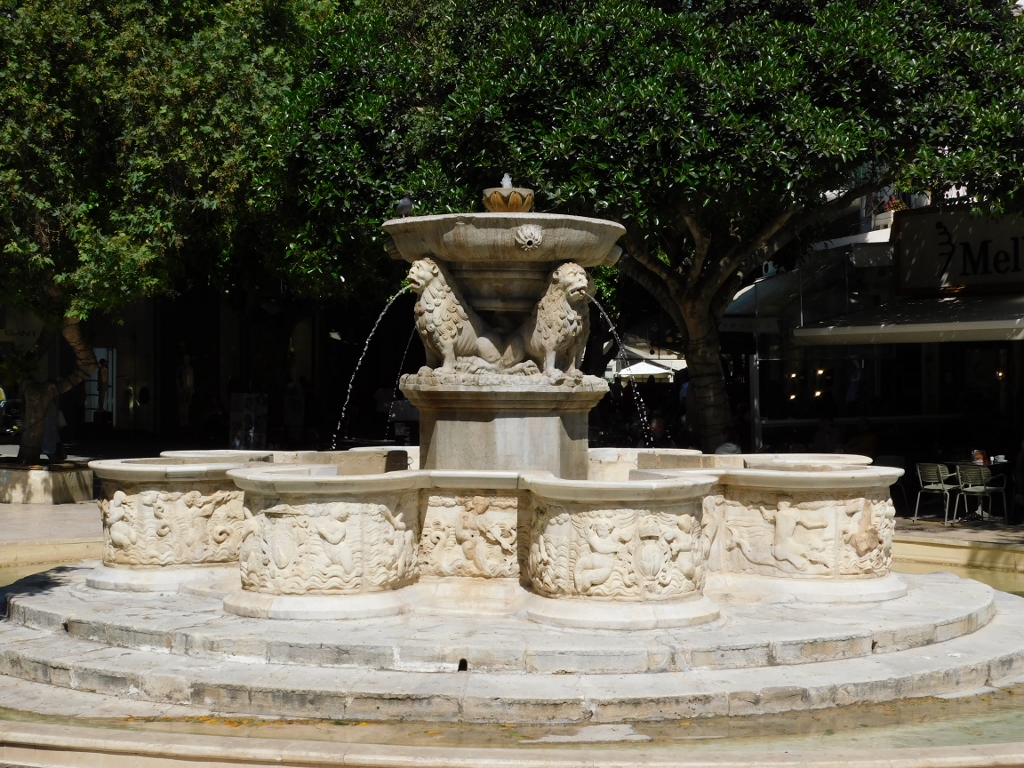 Morossini Fountain
Morossini Fountain
Before I sat down to have breakfast, I wanted to go to the Tourist Office that is also located in this part of Heraklion, but the entrance door was locked. I found it a little odd, but I decided to sit down first, have a coffee and something to eat, thinking that the tourist office would certainly open in the meantime. After all, I was on Crete, an island in Greece, the tourist season was well on its way and tourists often need information. That’s what I was thinking.
When I found a place at the café/bakery, I got on the internet, looked up the Tourist Office and then I could not believe what the case was. Namely, it was a Saturday and the Tourist Office does not work on weekends!!!!!
Since, among other things, I wanted to ask them how I can transfer by public transportation to nearby Knossos (that was my plan for the following day), I decided to check this out on the internet. I found out that bus no. 2 runs from Heraklion to Knossos, I saw where the route of the bus was in order to go to the nearest stop and then I looked up the daily schedule only to find out that bus no. 2 would not even operate on the following day, since this was a Sunday!!!
Knossos is some 5 km away from the centre of Heraklion and I could certainly take a taxi the next day, but I thought this was unnecessary, so I immediately changed up my plan and decided to go there right away, on the first day, in order to visit the palace that, at least according to the ancient Greek legends, used to be the residence of King Minos and that also included the huge Labyrinth that was occupied by famous Minotaur.
As for the café/bakery, I took a savoury cheese pie following the advice given to me by the taxi driver, but I must admit I did not like it at all. Admittedly, the waitress offered some other type of pie to me, made with phyllo pastry, but I thought I should first take what the taxi driver advised and then this other version some other time. However, what I did not like here was the cheese, so I decided that I should actually not take any cheese pies while in Greece. After all, I also come from the Balkans and the people of the Balkans make cheese and phyllo pastry pies as a regular thing. Everybody in their own way. Myself included. And because of this, I know what I really like and which type of cheese I prefer. There was no reason for me to eat here a version of something I can make myself, while not liking this local version as much as I like mine.
*CHEESE PIE *
- 500 g of phyllo pastry
- 6 eggs
- 500 g white cheese (like feta cheese)
- 1 cup of yoghurt
- 1/2 cup of oil + some more for the phyllo pastry
- 1 cup of mineral water
- salt and sesame seeds
Crumble the white cheese and add three eggs. Mix it all and this is the filling. Depending on the thickness of the phyllo pastry, place 2 to 3 sheets one on top of the other, sprinkling each one with little oil. There is no fixed amount of oil for this depends on the taste. I do not like a very oily pie, but there are people who prefer it that way.
A package of 500 g of phyllo pastry by the rule contains 15-20 sheets, depending on their thickness. One should calculate how many rolled “sausages” there will be in the end in order to distribute the filling equally and it is applied like this: Along the edge closer to the person making the pie, a part of the filling is spread along the entire length and then the phyllo sheets should be rolled, but rather loosely, i.e., the pastry and the filling should not be squeezed tight. A “sausage” obtained in this manner should be placed on a greased baking tray. The same should be done with the rest of the phyllo pastry and the filling. Once all the “sausages” are placed into the tray, they should be cut into a few pieces; I usually cut them into four pieces.
Using the same bowl in which there was the cheese, put in the remaining three eggs, add some salt and mix. Then add the yoghurt and oil, and mix well again. Add the mineral water and mix it all. Pour this mixture over the pie in the tray and spread some sesame seeds on the top. You can also use nigella seeds.
Bake at 180 degrees C and when you take it out of the oven, let it cool a little and then cut again following the traces where the pieces of the pie were already cut before the baking.
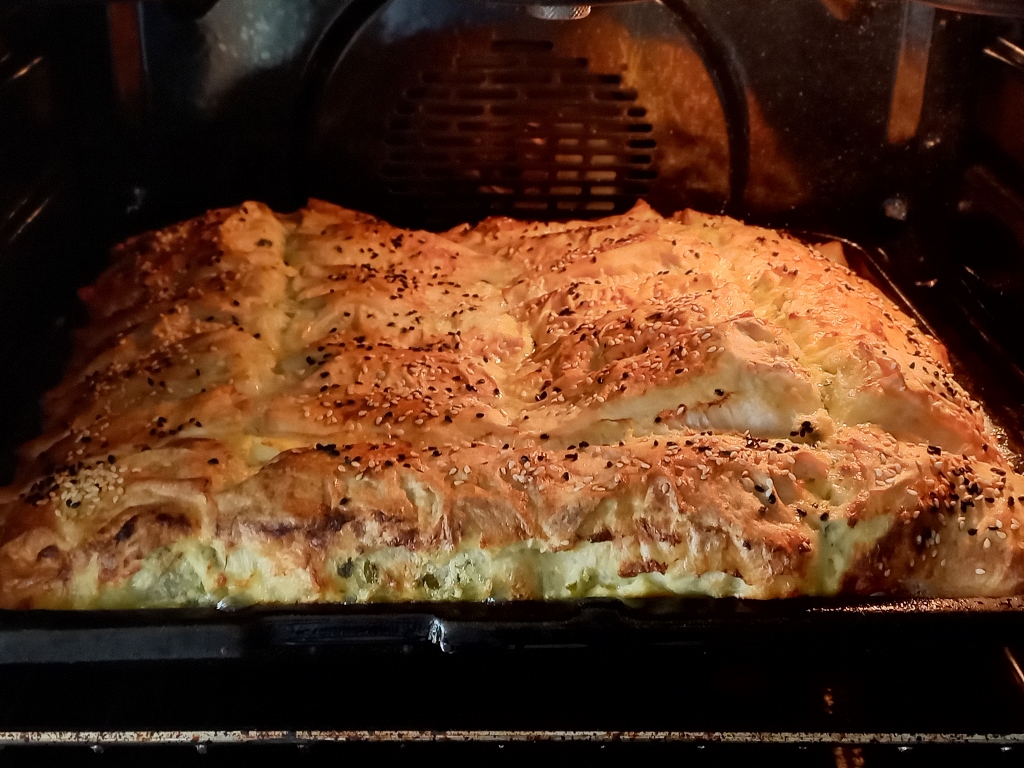 My version of cheese pie
My version of cheese pie
As for my stay on Crete, I followed one of the main streets to get to a well-known square in Heraklion, the Liberty Square (Eleftherias Square), and there was the bus stop. There was no board at the stop that would say which buses stopped there, so I asked a young man if no. 2 that runs to Knossos would pass there. He confirmed and then asked me if I had a bus ticket. I said I didn’t, but I would buy it, thinking I would pay to the driver when I enter the bus. Then this kind young man said it would be better (cheaper) if I bought a ticket at a kiosk and there by the stop there was a kiosk indeed (a tiny shop for food items, cigarettes, soft drinks, etc.). So this is what I did.
I waited a little and then the bus came that transferred me to Knossos.
Knossos is the name of a settlement, but this is also the place where visitors come in order to see the famous Palace.
Let me first say that the inhabitants of the islands in the Aegean Sea and east Mediterranean knew how to use copper already from 3000 years BCE and this enabled different cultures to develop both on these islands and in mainland Greece. One of the most significant ones is the Minoan civilization developed on the island of Crete which reached its summit around 1500 BCE.
When one visits Greece and the remains of the old civilisations that used to flourish in this part of the world, one unavoidably comes across ancient Greek legends and many of the characters mentioned in them are inextricably linked both to Crete and the European civilisation – starting from the very name of the continent – Europe. Namely, the old Cretan culture or civilisation got its name after the mythical King Minos who ruled here and who was the son of god Zeus and Phoenician princess Europa who rendered the name to the entire continent. As for the Minoan culture itself, it was named by Arthur Evans who conducted his archaeological research here at the beginning of the 20th century, after Crete was liberated from the Ottomans, and thus he brought the palace in Knossos to the light of the day.
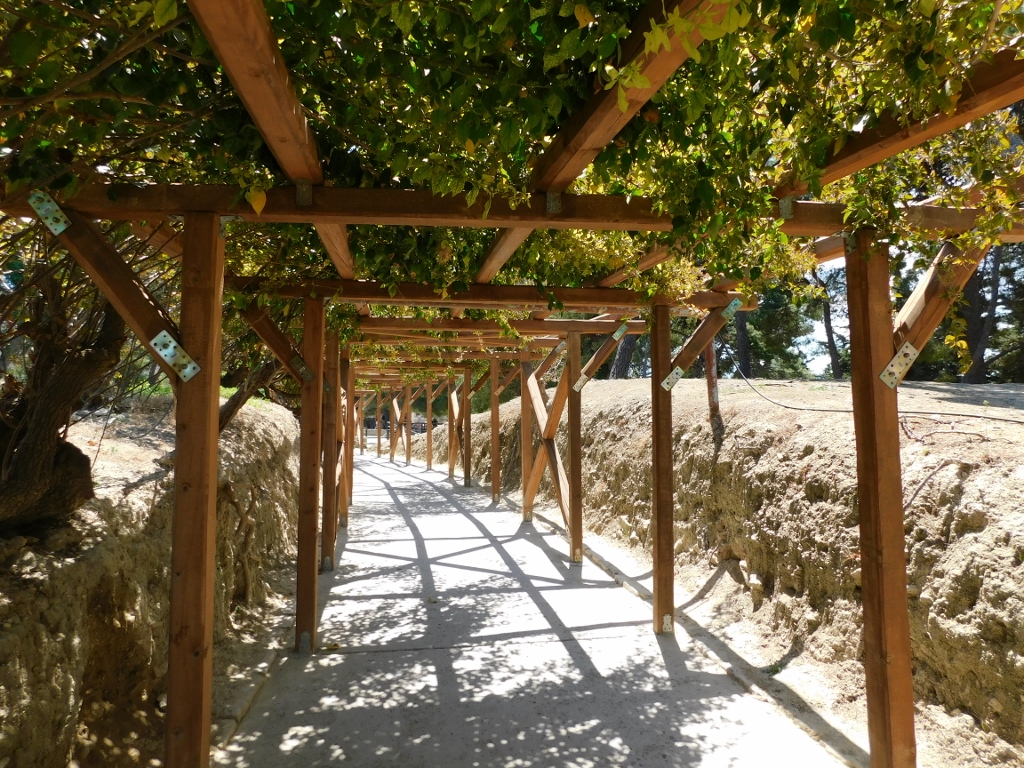 Access to the central part of the archaeological site of Knossos
Access to the central part of the archaeological site of Knossos
The palace in Knossos was the most important centre of the Minoan civilisation. Its remains were actually discovered already in 1878, but it was precisely Arthur Evans who conducted the main excavations during the first three decades of the 20th century, so it is often said that he discovered the palace. As this is a large site, numerous archaeological digs are carried out here even today.
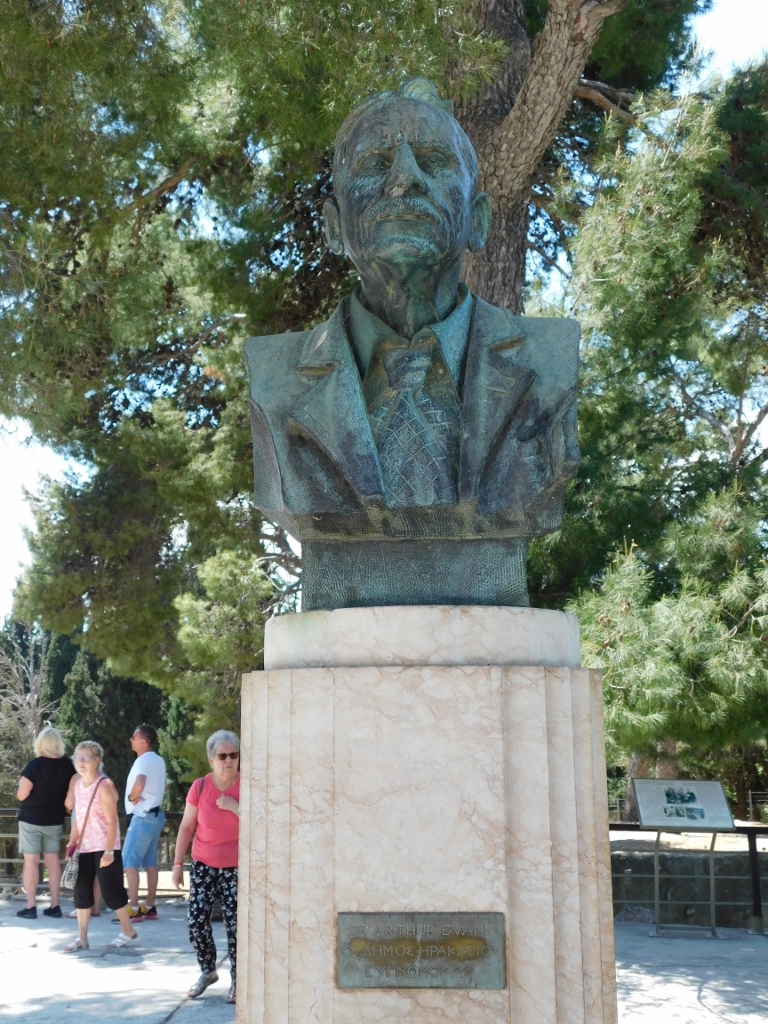 Monument to Sir Arthur Evans at the Knossos site
Monument to Sir Arthur Evans at the Knossos site
There used to be a settlement here already during the Neolithic (6700-3200 BCE) and after that period a very specific civilisation started to develop. The reason why the settlement was founded here is that the site was close to the sea and yet at the place where two water streams converged, while in an area with fertile land. In other words, ideal for living.
The Minoan civilisation started to develop around 3200 BCE and the first palace was built here around 1900 BCE. Since it was destroyed and damaged several times, a new one was built at the same place and it was expanded during the period from 1700 to 1450 BCE. At the final stage of the Minoan civilisation (1400-1100 BCE) this was the only palace that was still partially inhabited. It is precisely the existence of the palace within this settlement that is the main benchmark when talking about different developmental phases and existence of culture at this site.
This is in fact a palatial complex that consisted approximately of a rectangular paved courtyard surrounded by different wings of the palace, with a larger settlement around the palace. The palace is nowadays approached via the West Court where the visitor may see huge Kouloures, large pits made of stone.
 West Court, while the Kouloures may be seen to the left
West Court, while the Kouloures may be seen to the left
The function of these pits has not been clarified fully and there are only theories about what they were used for. On the one hand, it is believed they were used for depositing waste, while on the other, that they were used for storing surplus of harvested grain.
From this court, one can see some parts of the settlement that surrounded the palace. Still, they could not be approached in May 2022. I’m not even sure it would make any sense for me, since I don’t actually know much about ancient settlements, but it was certainly interesting to see them from the level of the West Court.
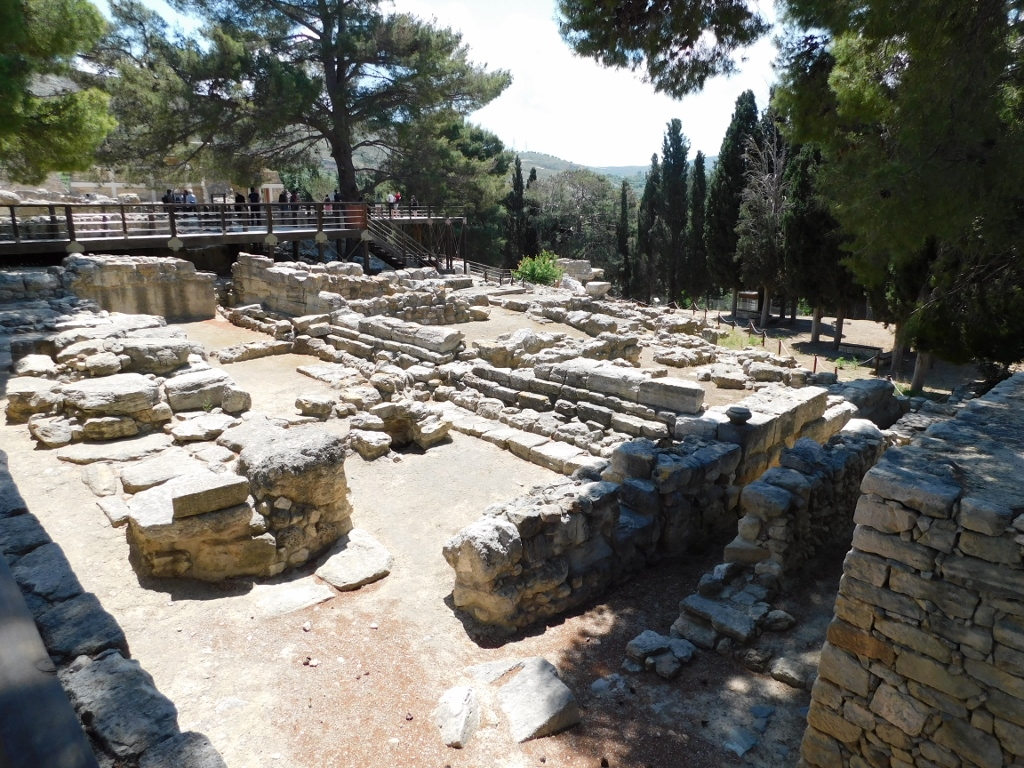 Parts of the settlement around the Knossos Palace as seen from the level of the West Court
Parts of the settlement around the Knossos Palace as seen from the level of the West Court
From the West Court one can also see the West Facade of the Palace.
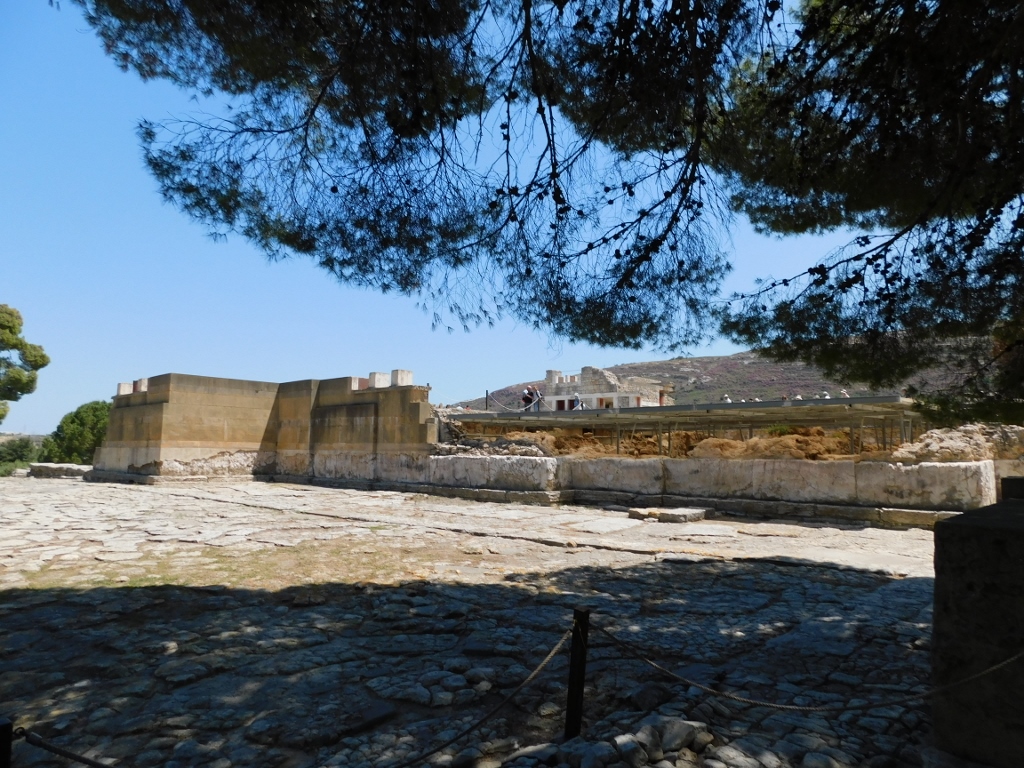 West Facade of the Palace
West Facade of the Palace
Following the path for visitors, from the elevation it is possible to see some other parts of the settlement that used to surround the palace. The palace was built on the top of a hill and this position nowadays allows for a fine view at the remains of the settlement and the surroundings.
 Parts of the settlement around Knossos Palace (to the right is the so-called South House)
Parts of the settlement around Knossos Palace (to the right is the so-called South House)
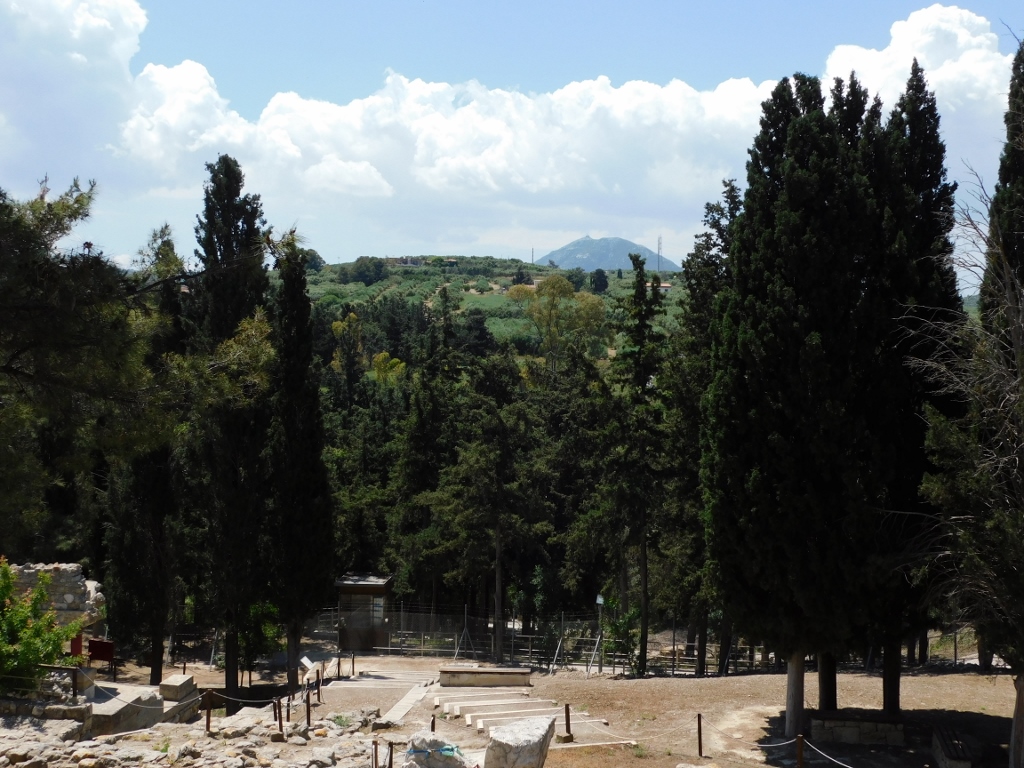 Parts of the settlement around Knossos Palace and the surroundings
Parts of the settlement around Knossos Palace and the surroundings
At first, one needs to follow the visitor path, but later it is possible to visit whatever you want and in any random order.
As for the palace itself, some parts have been reconstructed in order to provide a better idea of what the palace may have looked like originally. Thus, you fist come across a part of the South Propylaeum.
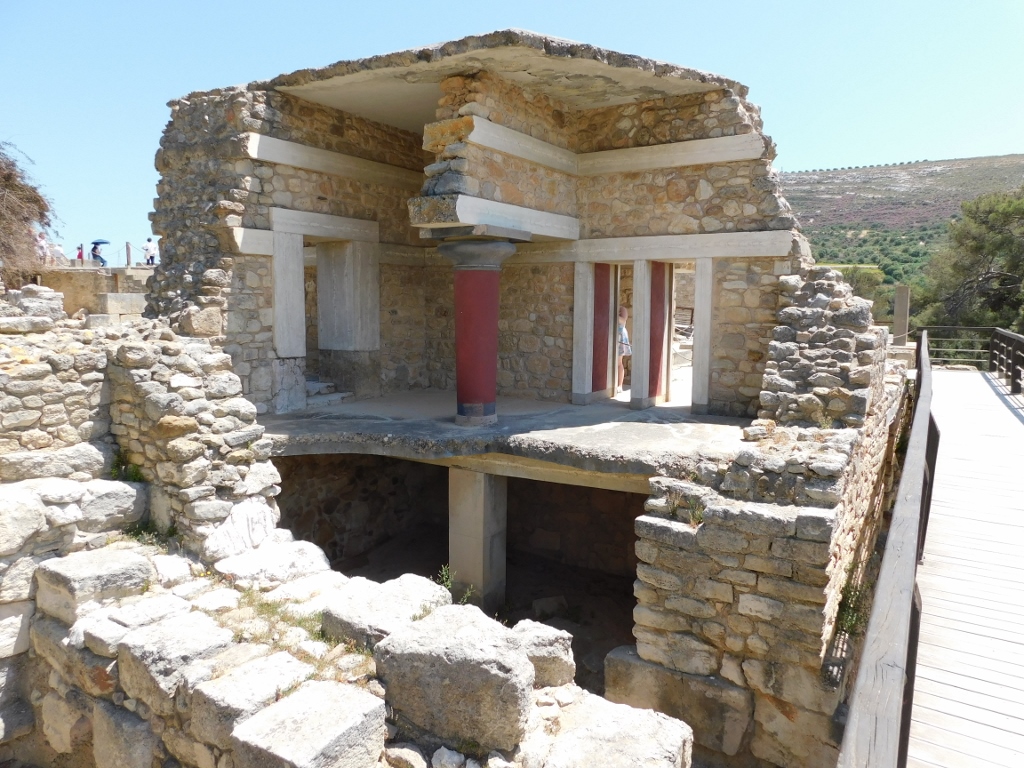 Reconstructed part of Knossos Palace, the South Propylaeum
Reconstructed part of Knossos Palace, the South Propylaeum
These reconstructed parts are certainly beautiful, but I must admit that for somebody who is a total layman, like me, it is really difficult to visualise what this actually all looked like. This is contributed to, among other factors, by the exceptional complexity of the building. Not only is the Palace huge and that it used to take up a significant surface area, there is also an incredible myriad of rooms. I was consoled by the fact that I was not the only one to be confused by such number of rooms and the complexity of the palace that on account of all of this leaves an impression of being like – a labyrinth!
This is an intentional play on words on my part, since the very origin of the word “labyrinth” is inextricably linked right to this palace. Namely, according to the legend, the palace was built by Daedalus, a famous Greek builder, inventor, sculptor and painter, in order to keep there Minotaur, a creature that was part man and part bull. He was born by the wife of King Minos, Pasiphaë, who cheated on her husband with the Cretan Bull whom she fell in love with. (Oh, yes... the ancient Greek legends are indeed odd and pictorial.)
Probably because of this oddity, I have always found stories from the Greek mythology interesting, so let me briefly mention a couple of them that are linked to the Palace in Knossos.
When Daedalus finished with the construction of the Palace (and the Labyrinth), King Minos prohibited him from leaving the island and locked him up. While on Crete, Daedalus was joined by his son Icarus. In order to flee the island, Daedalus created for him and his son large feather wings that were glued together using wax. Although he gave very clear instructions to Icarus as to where he should fly, as is usually the case, the youth of his son made the latter forget the wise advice of his father and he joyfully kept flying up and down, thus getting too close to the Sun. The warmth of the Sun’s rays melted the wax that kept the wings together and thus the unfortunate Icarus fell into the sea and perished.
Meanwhile, lots of things took place within the wider realm of Ancient Greece and so it happened that Athens regularly had to send as sacrifice to Crete 7 young men and 7 young women in order for them to be devoured by Minotaur. One year, Theseus, a son of King Aegeus, volunteered to go and kill Minotaur. And he did that, but primarily thanks to the ball of thread he received from Ariadne, a daughter of the Cretan King Minos, what is even more important he managed to find his way out of the Labyrinth. Let me just mention that in his victorious return to Athens, Theseus forgot to replace the sails on his ship and thus his father thought he had been killed and because of the grief he threw himself into the sea that was then named after him – the Aegean Sea.
And, finally, I should say that on account of the complexity and the myriad of rooms within the Palace, the word “labyrinth” survived throughout the centuries and has been used in order to denote spaces that are so intricate that one can easily get lost in them and to such a degree as to be difficult to find the way out. And yet, it is also believed that the root of the word itself could come from the word labrys meaning double-bladed axe. These axes were widely used in the Minoan civilisation and their images could be seen on the walls of the palace. This would mean that the original meaning of the word “labyrinth” would actually refer to axes and not to complex and complicated architectural spaces and even Evans himself thought that the word “labyrinth” could mean “the house of double axe.” Still, this is only one of the linguistic theories.
What I needed to do now was to start with the visit to Knossos Palace. It was a day, Minotaur was long gone and I did not need Ariadne’s thread.